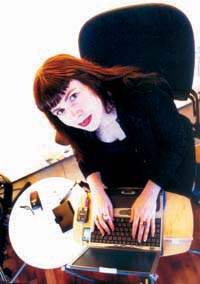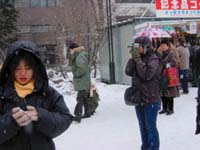Bridging the Digital Gender Divide
Back to Contents of Issue: May 2002
|
|
|||
|
by Catherine Pawasarat Photos by Kristen McQuillin |
|||
 MUCH TALK HAS BEEN made of this country's e-Japan initiative, aiming to secure Japan's place as a world leader in digital technology by 2005. But who exactly is on the ground, blazing this new Japanese discipline of
intanetto-do, the 'way of the Internet?' If recent statistics on Japanese women's participation in information and communications technologies (ICT) are any indication, Hiroshi, Daisuke and their ilk are traveling the information highway bachelor-style. MUCH TALK HAS BEEN made of this country's e-Japan initiative, aiming to secure Japan's place as a world leader in digital technology by 2005. But who exactly is on the ground, blazing this new Japanese discipline of
intanetto-do, the 'way of the Internet?' If recent statistics on Japanese women's participation in information and communications technologies (ICT) are any indication, Hiroshi, Daisuke and their ilk are traveling the information highway bachelor-style.
In a survey of 20 countries, Japan trailed in last -- behind Italy and the Czech Republic -- for the percentage of women in its ICT workforce, with a wimpy 17 percent. By comparison, the corresponding percentages were 38 in the United States, and 32 in Germany and South Korea. Cut to DigitalEve Japan. This burgeoning Tokyo-based, nonprofit group is out to bring some onna pawa 'woman power' to digital Japan. If DEJ has anything to say about it, more and more women here are going to have a fair shot at the 1.85 million IT jobs expected to be up for grabs by 2005. In such a tech-savvy country as Japan, how did women get left behind anyway? A lot of it has to do with the glass ceiling, still very much in place years after women's lib came and went in most other industrialized countries. "This is still a man's society. Lots of jobs for women are really only geared to last until they turn 35 years old, and this is usually decided by men," says Chiharu Kawai, a DEJ member who works with software localization at an American firm in Tokyo.
Unlike many of their other Asian sisters, Japanese girls never get the message that the scientific arts are a quick and sure way to success. "There's still no sense, for example, that a Japanese woman can be an engineer if she wants to," Kawai says.
"Women who don't work in IT get way behind in technology. Helping them is really meaningful work," says Aki Shiozawa, an IT consultant who also manages the DEJ mailing list. Shiozawa works with computer systems for business, but says she's attracted to DEJ for what it can teach her in digital design. Monthly DigitalEVEnings let members network, and practice Japanese and English language skills. This summer DEJ offers a series of workshops for IT beginners, starting with how to buy a computer and moving through the basics of MS Office and getting online. Judging by DEJ's growing membership, the group is filling a genuine need. After launching in February 2001 with 90 members, it boomed to 400 within a year. Around 40 percent of the members are Japanese, and the other 60 percent represent about a dozen different nationalities. "Through translated Web content, Japanese-language workshops and other means, we're working to change the ratio so that the majority of members are Japanese," says DEJ co-leader Kristen Elsby, an information architect at the UN University in Tokyo. There's no question that more digital skills will open doors for women in Japan, especially since, amidst Japan's economic woes, IT jobs still outstrip IT-savvy workers. |
|||
Note: The function "email this page" is currently not supported for this page.


 What does DEJ do? Its Internet mailing list is the focal point: Here members (who include men) swap tips on everything from the latest digital releases to the ins and outs of HTML, remedies for a corrupted registry or comparisons of the best broadband services available. For hands-on experience, the group offers monthly three-hour workshops on specific digital skills. These include the likes of optimizing Macromedia Fireworks, making the most of an Excel spreadsheet, creating digital video or understanding database design theory.
What does DEJ do? Its Internet mailing list is the focal point: Here members (who include men) swap tips on everything from the latest digital releases to the ins and outs of HTML, remedies for a corrupted registry or comparisons of the best broadband services available. For hands-on experience, the group offers monthly three-hour workshops on specific digital skills. These include the likes of optimizing Macromedia Fireworks, making the most of an Excel spreadsheet, creating digital video or understanding database design theory.



